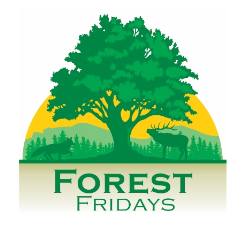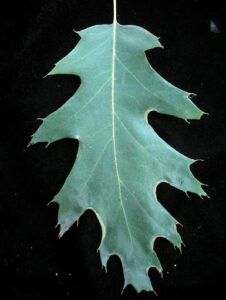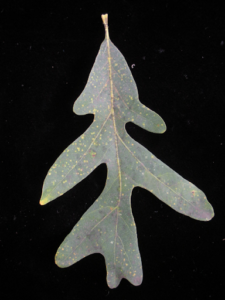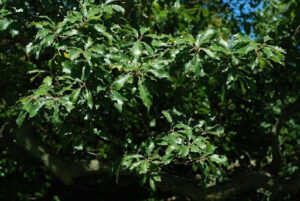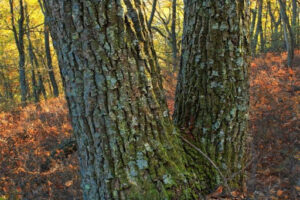A Celebration of Oaks, Part I: Arbor Day 2023
By Greg Podniesinski, Forest Fridays
Today is Arbor Day, a holiday meant to encourage the public to plant, conserve, and appreciate trees. It seems fitting to celebrate (and appreciate) an important and diverse group of native Pennsylvania trees: the oaks! Pennsylvania is home to sixteen native oak species, adapted to nearly every type of habitat in the Commonwealth, from dry ridgetops to wet, swampy bottomlands.
Red versus White
Pennsylvania oaks belong to the genus Quercus and can be split into two main groups: the Red Oaks (ten species), which have bristles at the end of their leaf tips or lobes and have acorns that take two years to mature, and the White Oaks (six species) that lack bristles on their leaf tips and have acorns that mature in one growing season. Some common “red oak” species include northern red, black, scarlet, and pin oaks. Common “white oaks” include white, chestnut and swamp white oaks.
Left – Northern Red Oak leaf (note bristles at the tips of each lobe).
Right- White Oak Leaf (note rounded lobes without bristle tip), Photos by Bruce Kirchoff, licensed under CC by 2.0.
Versatility
Pennsylvania has one of the most diverse landscapes in the country, with eleven different ecoregions, and each has its own mix of native oak trees. Some oaks, like the white, northern red, and black oak, can occur just about anywhere in the state, while others are more specialized. Dry ridges and rocky mountain tops, typical of the Ridge and Valley and the Poconos, are home to the chestnut and scarlet oaks as well as our smaller, shrubby species like the scrub (bear) oaks. Other species have a fondness for wet feet and are found in vernal pools, wet bottomlands, and swamps, like the pin and swamp white oaks.
Scarlet Oak fall foliage. Pin Oak leaves, note deeply cut lobes typical of this species. Photo by Famartin, licensed under CC BY-SA 4.0. Photos by Bruce Kirchoff, licensed under CC by 2.0.
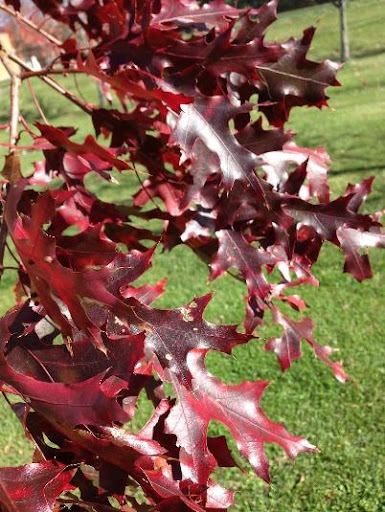
Left – Scrub Oak leaves. Photo by Bruce Kirchoff, licensed under CC by 2.0.
Right – Bark of the Chestnut Oak. Photo by Nicholas is licensed under CC BY 2.0. Both species are adapted to fire; scrub oak will burn down to the ground, then vigorously resprout. Chestnut oak’s thick bark protects it from fire.
Several of our oak species are “Southerners”, and thus very common south of us, just creeping into the southern tier of PA. The willow oak can be found in the Philly area (in Neshaminy State Park, and oddly enough along the right-of-way of I-95), where it enjoys moist to wet woods. South of PA, the willow oak is often planted as a city street tree and is commonly used in landscaping. In nearby Chester County, you can find two other oaks, the blackjack and post oak, especially on serpentine barrens. They are widespread in the southeast and southcentral US. These are small to medium-sized oak species with very dense wood (post oak has been used for railroad ties and other applications requiring tough, rot-resistant wood). It’s interesting that both species are often used as charcoal for Texas barbecues.
Another “Southerner” is the aptly named southern red oak, which has similar characteristics to our more common northern red oak. It also just peaks into PA in the southeast corner of the state, but is widespread to the south, occurring from Texas and Arkansas all the way to the Atlantic Coast. The southern red oak is an important hardwood timber tree across most of its range.

Top left: Blackjack Oak
Top right: Southern Red Oak
Bottom middle: Post Oak
Photos by Bruce Kirchoff, licensed under CC by 2.0
Stay tuned for Part II, and Happy Arbor Day!
About the author:
Greg Podniesinski is chief of the Natural Heritage Section of the PA Department of Conservation and Natural Resources – Bureau of Forestry, as well as State Director of the PA Natural Heritage Program. Podniesinski has worked for the Bureau for the last six years, and a total of 10 years with DCNR. He has also spent 20 years working with the PA Natural Heritage Program. Podniesinski earned his B.S. in Biology from the University of Notre Dame, his M.S. in Zoology from the University Of Maine and his Ph.D. in Environmental Science from the SUNY College of Environmental Science and Forestry at Syracuse. He has a particular interest in plant community ecology, floodplains, fens, bogs, shale and serpentine barrens, and is especially fond of native orchids and serpentine barren plants. Learn more about DCNR here.
